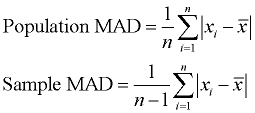When calculating the formulas for mean absolute deviation (MAD), variance, and standard deviation, it is important to know if you are working with an entire population (where you have all of the possible data), or if you are working with only a sample (a part) of the data. In addition, if you are using a sample of the data, you need to know if you will be making generalizations about the entire population, based upon this sample. The only difference between the formulas in each section is division by n or n - 1.
Read more about these formulas under Measures of Spread.
Note: When working with "sample data sets", statisticians use n for the number of data entries and
This task is only dealing with the heights of fourteen year old boys in one specific class. The intent is not to estimate the heights of all fourteen year old boys in the world. The "population" in this task is only the fourteen year old boys in your Algebra class. Since you have the entire population available for this situation, you will be finding the population variance (dividing by n).
In this situation, the population is extremely large. There is actually no way of obtaining all of the data in the population. You simply will not have all of the data available for your use. You will need to use a sample of the population. It will be necessary to "estimate" the population's variance based upon the variance of a sample of the population. You will be finding the sample variance (dividing by n - 1).
Directions: For the following problems, decide if the situation is dealing with a "population" data set, or with a "sample" data set. Explain your decision. 1. Mrs. Smith wants to do a statistical analysis on students' final examination scores in her math class for the past year. Should she consider her data to be a population data set or a sample data set?
2. A group of students surveys 100 students from their freshman class to determine the number of pets in each student's household. The group plans to compute statistical findings on their data and generalize these findings to the homes of all freshmen students. Should the group consider their data to be a population data set or a sample data set?
Note: The practice of dividing by n - 1 (instead of n) when working with a sample of the entire population, produces a slight difference in the final calculation. This slight difference allows the sample to give a better mathematical estimate of the population. Think of dividing by n - 1 (instead of n) in the sample as a means of "compensating" for the fact that we are working with a sample of the population, rather than with the entire population. It statistically gives the best estimate.
Topical Outline | Algebra 2 Outline | MathBitsNotebook.com | MathBits' Teacher Resources
|
||||||||||||||||||||||||||||||






